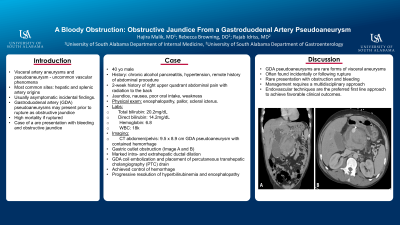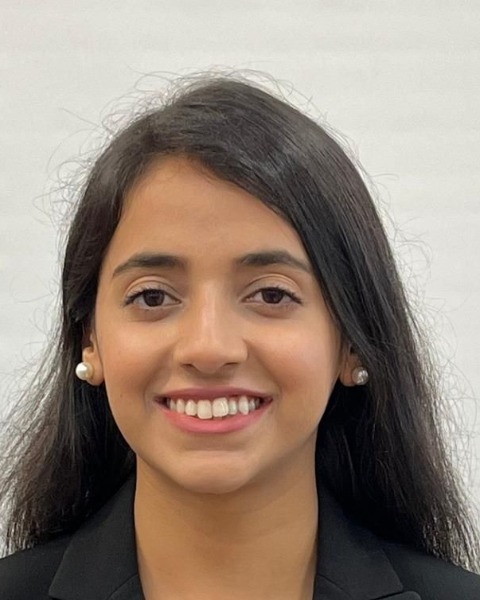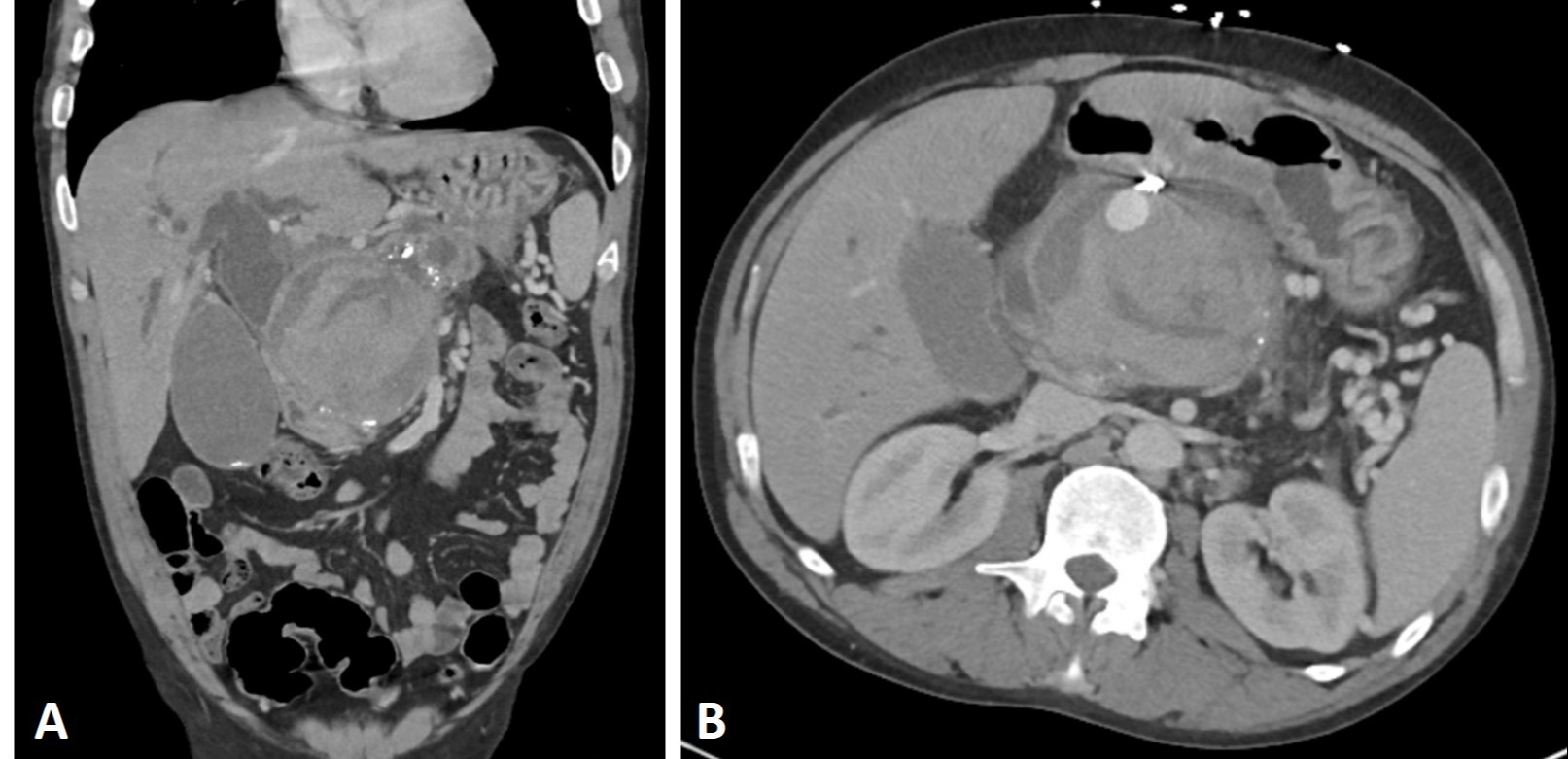Back


Poster Session E - Tuesday Afternoon
Category: Biliary/Pancreas
E0050 - A Bloody Obstruction: Obstructive Jaundice From a Gastroduodenal Artery Pseudoaneurysm
Tuesday, October 25, 2022
3:00 PM – 5:00 PM ET
Location: Crown Ballroom

Has Audio

Hajira Malik, MD
University of South Alabama
Mobile, Alabama
Presenting Author(s)
Hajira Zafar Malik, MD1, Rebecca Browning, DO2, Rajab Idriss, MD1
1University of South Alabama, Mobile, AL; 2University of South Alabama College of Medicine, Mobile, AL
Introduction: Visceral artery aneurysms and pseudoaneurysm are uncommon vascular phenomena, with hepatic and splenic artery origins representing the most common sites, that have a high mortality if ruptured. Typically, these are asymptomatic incidental findings discovered on imaging. Gastroduodenal artery (GDA) pseudoaneurysms may present prior to rupture as obstructive jaundice.
Case Description/Methods: A 40-year-old male with a history of chronic alcohol pancreatitis, hypertension, remote history of abdominal procedure who presented to an outside hospital with two-week history of right upper quadrant abdominal pain with radiation to the back, jaundice, nausea, poor oral intake, and weakness. Upper endoscopy showed erosive esophagitis with no varices and a small hiatal hernia. On examination he was noted to be encephalopathic with pallor and scleral icterus. Total bilirubin was 20.2mg/dL, direct 14.2, hemoglobin 6.8, WBC 18k, CT abdomen/pelvis revealed a 9.5 x 8.9 cm GDA pseudoaneurysm with contained hemorrhage causing gastric outlet obstruction and marked intra- and extrahepatic ductal dilation, at which point he was transferred to our tertiary level care center. He underwent GDA coil embolization and placement of percutaneous transhepatic cholangiography (PTC) drain with control of hemorrhage, progressive resolution of hyperbilirubinemia and encephalopathy.
Discussion: GDA pseudoaneurysms are extremely rare forms of visceral aneurysms, often found incidentally or following rupture which worsens prognosis. Occasionally, GDA pseudoaneurysms will present as obstructive jaundice as in the case of this patient. Management of these rare vascular phenomena require a multidisciplinary team, with endovascular techniques as the preferred first line approach, to achieve favorable clinical outcomes.

Disclosures:
Hajira Zafar Malik, MD1, Rebecca Browning, DO2, Rajab Idriss, MD1. E0050 - A Bloody Obstruction: Obstructive Jaundice From a Gastroduodenal Artery Pseudoaneurysm, ACG 2022 Annual Scientific Meeting Abstracts. Charlotte, NC: American College of Gastroenterology.
1University of South Alabama, Mobile, AL; 2University of South Alabama College of Medicine, Mobile, AL
Introduction: Visceral artery aneurysms and pseudoaneurysm are uncommon vascular phenomena, with hepatic and splenic artery origins representing the most common sites, that have a high mortality if ruptured. Typically, these are asymptomatic incidental findings discovered on imaging. Gastroduodenal artery (GDA) pseudoaneurysms may present prior to rupture as obstructive jaundice.
Case Description/Methods: A 40-year-old male with a history of chronic alcohol pancreatitis, hypertension, remote history of abdominal procedure who presented to an outside hospital with two-week history of right upper quadrant abdominal pain with radiation to the back, jaundice, nausea, poor oral intake, and weakness. Upper endoscopy showed erosive esophagitis with no varices and a small hiatal hernia. On examination he was noted to be encephalopathic with pallor and scleral icterus. Total bilirubin was 20.2mg/dL, direct 14.2, hemoglobin 6.8, WBC 18k, CT abdomen/pelvis revealed a 9.5 x 8.9 cm GDA pseudoaneurysm with contained hemorrhage causing gastric outlet obstruction and marked intra- and extrahepatic ductal dilation, at which point he was transferred to our tertiary level care center. He underwent GDA coil embolization and placement of percutaneous transhepatic cholangiography (PTC) drain with control of hemorrhage, progressive resolution of hyperbilirubinemia and encephalopathy.
Discussion: GDA pseudoaneurysms are extremely rare forms of visceral aneurysms, often found incidentally or following rupture which worsens prognosis. Occasionally, GDA pseudoaneurysms will present as obstructive jaundice as in the case of this patient. Management of these rare vascular phenomena require a multidisciplinary team, with endovascular techniques as the preferred first line approach, to achieve favorable clinical outcomes.

Figure: CT Abdomen and Pelvis with IV contrast demonstrating gastroduodenal (GDA) pseudoaneurysm with active hemorrhage causing mass effect and intra- and extrahepatic ductal dilation.
Disclosures:
Hajira Zafar Malik indicated no relevant financial relationships.
Rebecca Browning indicated no relevant financial relationships.
Rajab Idriss indicated no relevant financial relationships.
Hajira Zafar Malik, MD1, Rebecca Browning, DO2, Rajab Idriss, MD1. E0050 - A Bloody Obstruction: Obstructive Jaundice From a Gastroduodenal Artery Pseudoaneurysm, ACG 2022 Annual Scientific Meeting Abstracts. Charlotte, NC: American College of Gastroenterology.
